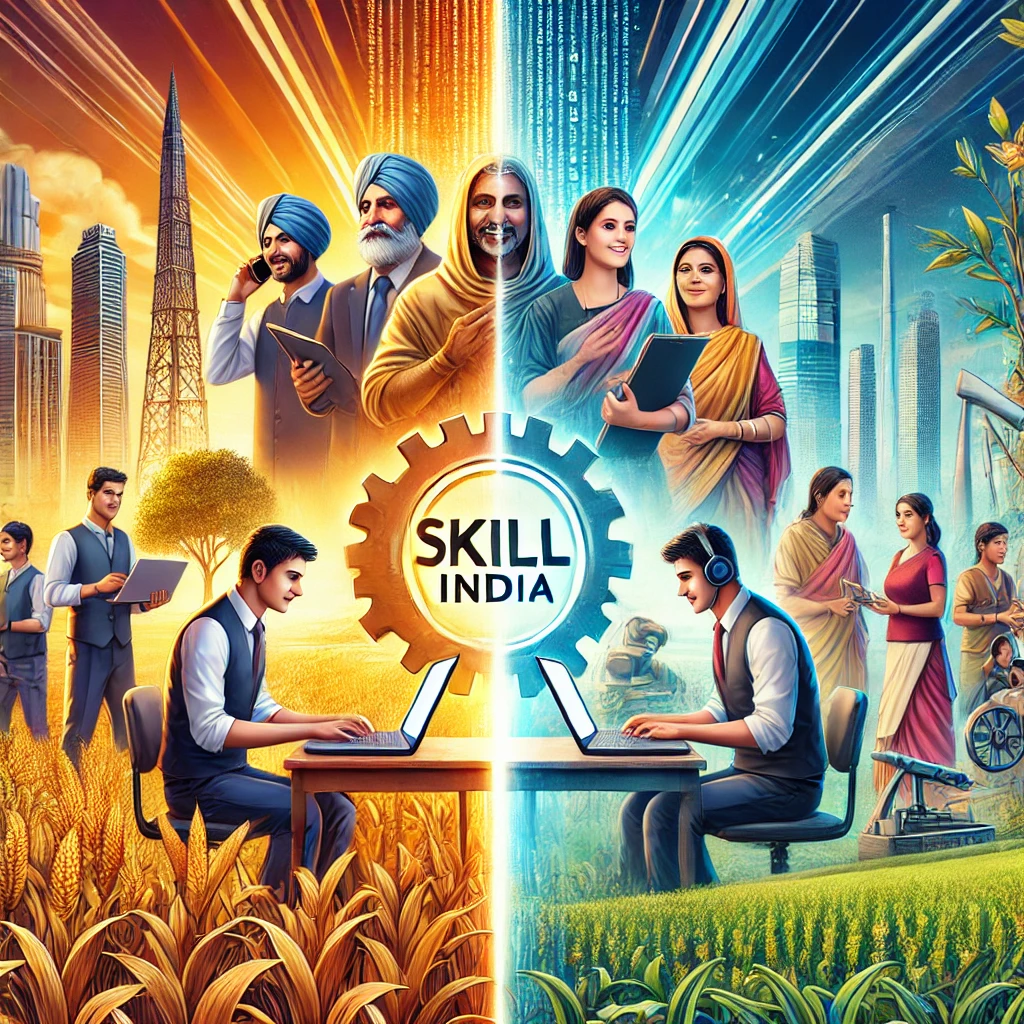Skill India’s Influence on Urban and Rural Workforce Development
Introduction
India, one of the fastest-growing economies in the world, faces a significant challenge in balancing urban and rural workforce development. With diverse skill requirements and varying levels of accessibility, the urban and rural workforces present unique challenges and opportunities. Recognizing this, the Skill India initiative has become a transformative force, addressing these disparities and equipping millions with the tools they need to contribute meaningfully to the economy.
This blog explores Skill India’s pivotal role in shaping urban and rural workforce development, highlighting its strategies, successes, challenges, and future potential.
Understanding Skill India
What is Skill India?
Skill India, launched in 2015, is a comprehensive program designed to empower the Indian workforce by enhancing employability through skill development. Under the leadership of the Ministry of Skill Development and Entrepreneurship (MSDE), the initiative aims to equip individuals with industry-relevant skills, foster entrepreneurship, and create job opportunities across urban and rural landscapes.
Key Objectives of Skill India
Enhance Employability: Bridge the gap between industry demand and workforce skills.
Promote Inclusivity: Ensure skill development opportunities for underrepresented groups, including women and marginalized communities.
Foster Economic Growth: Boost GDP by equipping workers with skills that match evolving economic needs.
Integrate Technology: Leverage digital tools to make training accessible across diverse geographies.
Skill Development in Urban Workforce
Challenges Facing the Urban Workforce
High Competition: Urban centers attract a large population, leading to stiff competition for jobs.
Skill Mismatches: Rapid technological advancements have created skill gaps among the urban workforce.
Youth Unemployment: Despite higher educational attainment, many urban youths remain unemployed due to a lack of practical, job-ready skills.
Skill India’s Role in Urban Development
Upskilling Programs: Initiatives like the Pradhan Mantri Kaushal Vikas Yojana (PMKVY) offer advanced skill training in IT, healthcare, and financial services.
Digital Learning Platforms: Programs like eSkill India enable urban youth to access online courses, ensuring continuous learning and skill enhancement.
Collaborations with Corporates: Partnerships with companies ensure industry-relevant training, increasing job placement rates in cities.
Success Stories from Urban Centers
Digital Marketing Marvel: Rajesh, a young man from Mumbai, enrolled in a digital marketing course under Skill India and now manages a flourishing marketing agency, catering to clients worldwide.
Tech-Savvy Transformation: Priya, a graduate from Delhi, pursued an AI programming course, landing a lucrative job in a multinational company.
Skill Development in Rural Workforce
Challenges Facing the Rural Workforce
Limited Access to Training: Rural areas often lack infrastructure for proper skill development.
Dependency on Agriculture: Over 60% of the rural workforce relies on agriculture, which is subject to seasonal and economic fluctuations.
Migration to Urban Areas: Lack of local opportunities pushes rural workers to migrate, leading to urban overcrowding.
Skill India’s Interventions in Rural Development
Rural-Focused Programs: Schemes like the Deen Dayal Upadhyaya Grameen Kaushalya Yojana (DDU-GKY) focus on skill development in rural areas, offering vocational training and job placements.
Agricultural Skill Training: Programs on modern farming techniques, organic agriculture, and food processing are transforming the traditional agrarian economy.
Mobile Training Centers: These bring training facilities to remote areas, reducing geographical barriers.
Support for Artisans: Tailored initiatives for craftspeople enhance traditional skills, helping them access national and international markets.
Rural Success Stories
Weaving Success in Assam: Kamala, a traditional weaver, utilized Skill India’s support to modernize her techniques and expand her business to global markets.
Organic Farming Pioneer: Rajiv, a farmer from Bihar, adopted organic farming methods taught under Skill India, significantly increasing his yield and income.
Comparing Urban and Rural Impact
Key Similarities
Focus on Employability: Both areas benefit from targeted skill training that enhances job readiness.
Use of Technology: Digital platforms bridge gaps, ensuring training is accessible regardless of location.
Gender Inclusivity: Programs prioritize the inclusion of women and marginalized communities in both settings.
Key Differences
Policy Framework Supporting Skill India
National Policy on Skill Development and Entrepreneurship (NPSDE)
Lays the groundwork for integrating skill development into the national agenda.
Role of State Governments
Regional skill development missions complement Skill India’s efforts, addressing state-specific needs.
Funding and Public-Private Partnerships
Collaboration with industries ensures financial support and market-aligned training.
Future of Workforce Development Under Skill India
Focus on Emerging Sectors: Greater emphasis on AI, renewable energy, and advanced manufacturing.
Sustainable Growth: Encourage environmentally friendly practices in both urban and rural contexts.
Women-Centric Programs: Expand opportunities for women, especially in traditionally male-dominated sectors.
Data-Driven Decision Making: Use AI and big data to identify skill gaps and track program outcomes.
Conclusion
Skill India has emerged as a transformative force, bridging the urban-rural divide and preparing India’s workforce for the challenges of a rapidly changing global economy. By addressing unique regional needs and fostering inclusivity, the initiative lays the groundwork for sustainable growth and prosperity.
As we move toward 2030, the vision of a skilled, empowered, and equitable workforce is not just a possibility but a promise – one that Skill India strives to fulfill.
FAQs
1. What is the primary goal of Skill India?
The main goal is to equip individuals with industry-relevant skills to enhance employability and foster economic growth.
2. How does Skill India support rural areas?
Through programs like DDU-GKY, mobile training units, and agricultural skill development courses, Skill India addresses the unique needs of rural workers.
3. Is Skill India effective in creating jobs?
Yes, it has successfully created job opportunities through industry partnerships and vocational training programs.
4. What role do state governments play in Skill India?
State governments complement the initiative by implementing region-specific programs and policies for skill development.
5. How can one enroll in Skill India programs?
Individuals can register on the official Skill India portal or visit training centers to explore available courses.




